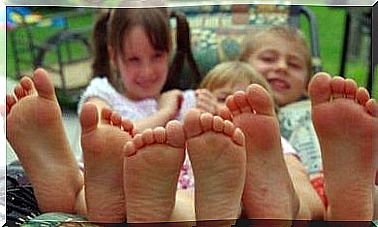Infectious Diseases Spread In Institutions

It is normal for children to suffer from colds, bronchitis, otitis or laryngitis when they first start in day care. Still, it should not worry you as it is a natural process that helps children build their immune system.
A child’s immune system is activated when faced with stimuli of infectious diseases, such as bacteria and viruses. This makes the child’s defenses stronger and in case of subsequent contact with the same virus, it awakens the immunological “memory”.
It is very normal for a child to get sick in kindergarten, but it will make her immune system stronger.
Children are exposed to several types of infectious diseases that are spread in day care institutions, so we need to be very attentive and informed about each one of them.
6 infectious diseases spread in day care institutions
Roseola, the “sixth disease”
Roseola or sudden rash is detected after the five diseases (measles, scarlet fever, rubella, varicella and megaloeritema). Therefore, it is also known as “the sixth disease”.
It begins with a very high fever, followed by a rash that first appears on the upper body and manifests itself towards the extremities.
These small pink spots do not sting and remain on the skin for 3 to 7 days, after which the faber falls off. All this is accompanied by mucus in the nose, sore throat and red eyes.
The disease usually ends without complications.
Ear infections
Among the diseases that spread in kindergartens are ear infections. Otitis is inflammation of the middle ear, which is usually due to a previous respiratory infection due to accumulation of mucus.
It is natural that children are more vulnerable to ear infections because their Eustachian tubes are even shorter, wider and more horizontal.

If a child suffers from this disease, he makes noises with the throat, coughs, has earache and is snotty. Sometimes fever also occurs.
Stomach flu
This disease occurs mainly in younger children and is the most common disease caused by rotavirus.
The main symptoms are diarrhea, vomiting, abdominal pain, fever and blood in the stool, in some cases.
It can be easily spread through diaper changes, or when cleaning children, so it is very important that hygiene is top notch.
Good hydration and a strict diet can significantly improve one’s health. Antibiotics are only recommended if the symptoms do not improve naturally.
Herpangina and “hand-foot-mouth” disease
Herpangina is a very common infection in babies that occurs as red dots on the back that become small sores. The “hand-foot-mouth” disease is manifested in the same way, but on the hands and feet.
Among the main symptoms are fever, sore throat and general malaise even before the sores come. The latter disappears even after 10 days.
This infection can be spread by contact or through the air. Maintaining good hydration and hygiene reduce the risk of infection.
Eye inflammation
This is one of the diseases that spread most hurriedly in day care institutions. It occurs when the conjunctiva, the membranes that surround the eye through the inner area of the eyelid and touch the front of the eye, is inflamed.
It is common in young children and can be caused by irritation, allergies or infection.
The eye begins to turn red due to the irritation and produce more tears, but they increase the feeling of painful itching.
Colds and severe pharyngitis
Among the most common symptoms of these conditions are fever, runny nose and stuffy nose. They are not serious diseases, but they increase the feeling of difficulty breathing and can cause greater discomfort to your child.
They can also cause loss of appetite and vomiting.

On the other hand, pharyngitis is usually accompanied by sore throat and cough with mucus.
These diseases generally disappear after a few days, but antipyretics can be used to control fever and reduce discomfort. Mucolytics and expectorants are not recommended unless your doctor tells you to.
Viruses provide protection for up to 6 years of age
Babies who go to kindergarten often get more infections than those who stay at home. This is because they are closer to other children, as we mentioned earlier.
A recent study showed that these children were protected against these bacteria between the ages of 3 and 6 due to their previous exposure to the virus .
Marieke de Hoog, the author of this study, explained that “ childcare speeds up the time that gastroenteritis suffers (before the age of 2), but it does not increase the incidence as it is combated in kindergarten.
In addition, he said that “it is possible that the protective effect continues after the age of 6, although further research is needed on this topic”.
The study, which involved more than 2,200 children under the age of 6, was published by Pediatrics Magazine.
It found that 83% of children had been in day care before their first birthday, and the researchers found a 13% higher degree of acute gastroenteritis or instetinal flu among children in day care in their first two years.
Many of these diseases that spread in day care are very difficult to avoid and even more difficult there as there are many children.
But with good hygiene and control, we can try to prevent it. The institution will inform you if there are symptoms of infectious diseases in the children.









